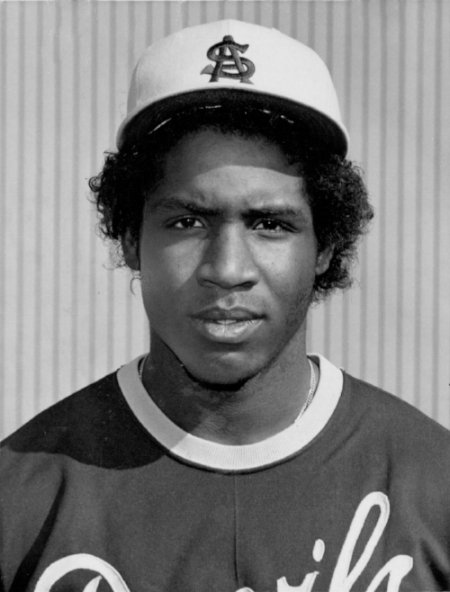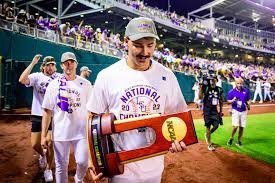A Diamond in Omaha’s Past: The Storied History of Rosenblatt Stadium and the College World Series
Writer Paul Fiarkoski grew up in a blue-collar neighborhood in south Omaha, just a mile or so from Rosenblatt Stadium. From his bedroom, he could see the stadium lights that rose above the distant trees and hear the roar and rumble of the crowd.
Such electricity, both from the diamond and throughout the neighborhood, was especially prominent in mid-June when Rosenblatt Stadium (known as “The Blatt” by locals) annually hosted the NCAA Men’s College World Series.
Source: Baseball Pilgrimages
From 1950 through 2010, Omaha’s “Diamond on the Hill” was home to this annual tournament, which brought many of the nation’s top college baseball players (and future Major League stars) to the Midwest to compete for a national championship.
Throughout these 60 years, Rosenblatt Stadium evolved into more than a ballpark. Just as older stadiums like Wrigley Field and Fenway Park are iconic symbols that connect us to professional baseball’s past, Rosenblatt Stadium became a beacon of college baseball that evoked a similar sense of nostalgia and reverence from fans.
And as the popularity of the College World Series (CWS) grew thanks to annual coverage on ESPN, baseball fans across the globe got to know and recognize Rosenblatt as a college baseball landmark — from the rainbow-colored seating and the iconic press box held up by a latticework of blue steel, to the retro scoreboard that stood sentinel over left field.
Despite this growing reverence, Rosenblatt hosted its last CWS game in 2010 and was razed two years later. A new stadium constructed in downtown Omaha took over hosting duties but, despite its modern amenities, has yet to take on the same status Rosenblatt once held.
“The College World Series will always conjure up the nostalgia of Rosenblatt Stadium,” said Fiarkoski, who wrote and published a book titled, “Romancing The Blatt: Memoir of a Love Affair with Omana’s Field of Dreams.” “And even though the stadium’s been gone for over a decade, people still have fond memories of Rosenblatt. It’s like a kinship.”
The History of Rosenblatt Stadium
Rosenblatt Stadium was constructed in 1948. Originally dubbed “Omaha Municipal Stadium,” the ballpark was built as the home field for the Omaha Cardinals, a single-A minor league team on which Hall of Fame pitcher Bob Gibson famously played..
Then in 1950, just two years after hosting its first game, Omaha Municipal Stadium and its 10,000-seat capacity attracted the College World Series. Both the tournament and the city have been attached ever since.
Throughout this stretch, the stadium continued to host minor league games during the summer. Most notably, the Triple-A Omaha Royals (now the Omaha Storm Chasers) began calling the stadium home in 1969.
By this time, the ballpark had been renamed Johnny Rosenblatt Stadium, shortened through the years to simply Rosenblatt Stadium.
Source: Baseball Pilgrimages
A former semipro baseball player, Johnny Rosenblatt was the mayor of Omaha from 1954 to 1961. He was largely considered most responsible for getting the stadium built in 1948 — even finding the hilltop site for the stadium’s location.
During its lifetime, the City of Omaha invested millions to expand Rosenblatt and keep it up to championship standards. This included adding bleacher seats and eventually growing the seating capacity to 23,100, making it at the time the largest minor league stadium in the country.
It’s been estimated that around 7 million fans had attended the CWS at Rosenblatt Stadium before its final game in 2010. These fans were welcomed annually by residents and business owners of the surrounding neighborhood, which became known for its food, drink, and tailgate parties.
“The culture in south Omaha was hard-working and tell it like it is,” Fiarkoski said. “That means profanity rolls off the tongue like prose, and they love to party. If there’s a baseball game, fireworks, or the College World Series, there’s a reason to party and invite people over to grill out in the front yard.”
Notable Superstars Who Played in the CWS at Rosenblatt
Though not all baseball superstars have played and excelled in college baseball, a number of notable Major League icons made their presence felt while playing in the College World Series at Rosenblatt Stadium. Here are some names you might recognize:
Dave Winfield, University of Minnesota
Participating in the CWS in 1973, this future MLB Hall of Famer was dominant as both a pitcher and hitter that year. During the series, he struck out 29 batters in 13 ⅓ innings while batting .467 in Omaha.
Barry Bonds, Arizona State
Source:
Bonds played in two College World Series with Arizona State, during his freshman and sophomore years in ‘83 and ‘84. In the ‘84 series, he tied an NCAA CWS record with seven consecutive hits. In 1996, he was named to the All-Time College World Series Team. Of course, Bonds went on to have a Hall-of-Fame-type career in the Majors, setting career and single-season home run records.
Roger Clemens, Texas
In 1983, Clemens helped lead the Texas Longhorns to an NCAA National Championship, going 2-0 with 16 strikeouts and a 1.33 ERA. He later became a household name as one of the most dominant pitchers in Major League Baseball history, winning seven Cy Young Awards.
Will Clark and Rafael Palmeiro, Mississippi State
A duo known as “Thunder and Lightning” in college, Clark and Palmeiro we teammates on the Mississippi State Bulldogs’ 1985 CWS team. Palmeiro went on to amass over 3,000 hits and 500 home runs in the majors, while Clark succeeded professionally as a six-time All-Star.
Terry Francona, Arizona
Before becoming a successful MLB manager, winning two World Series championships with the Red Sox, Francona (as a player) led Arizona to a 1980 championship at the College World Series. In doing so, he was named the Most Outstanding Player of the series.
Buster Posey, Florida State
Posey played in the 2008 College World Series with the Florida State Seminoles, which lost both their games. Despite this, Posey went on to win that year’s Collegiate Baseball Player of the Year award before being drafted by the Giants, where he would win three World Series titles and an MVP award.
Nomar Garciapara, Georgia Tech
Garciapara helped lead the Yellowjackets to the 1994 College World Series title game, where they lost to Oklahoma. He then went on to a successful MLB career, earning six All-Star selections and two batting titles.
The Legacy of Rosenblatt Stadium
Following its demolition in 2012, the site of Rosenblatt Stadium sadly became a parking lot for Omaha’s Henry Doorly Zoo, a long-time neighbor of the stadium. Fans of the College World Series will likely remember the 137-foot “Desert Dome” which prominently rose beyond the right-field bleachers of Rosenblatt.
As a tribute to Rosenblatt, Henry Doorly also created what they dubbed “Johnny Rosenblatt’s Infield at the Zoo” — a small grassy whiffle ball field that features a plaque honoring Rosenblatt Stadium as well as a prominent sign and several seats from the original ballpark. The original foul poles from Rosenblatt also remain in place within the lot.
Charles Schwab Field (formerly TD Ameritrade Park), which replaced Rosenblatt as Omaha’s newest home for the College World Series, has also taken steps to pay tribute to the older stadium. Not only does Charles Schwab Field continue to use the original Hammond organ used for decades during the CWS, but the outfield dimensions are also the same as those at Rosenblatt Stadium.
The stadium capacity is also nearly identical, despite capacity being one of the reasons given for building a new stadium.
Another thing that hasn’t changed since the demolition of Rosenblatt is the quality of talent the College World Series continues to bring through Omaha. Future superstars who played in the CWS since it moved to a newer stadium include:
Paul Skenes, LSU
Source: LSU Sports
Currently an MLB rookie making a name for himself as a member of the Pittsburgh Pirates, Skenes was instrumental in leading LSU to a national championship in 2023. In doing so, he was named the Most Outstanding Player of the College World Series, delivering dominant performances on the mound including a record-tying 17-strikeout game.
Gerrit Cole, UCLA
One of the few players who played in both Rosenblatt and TD Ameritrade (now Charles Schwab Field), Cole’s elite pitching led UCLA to both their 2010 and 2012 CWS appearances. Of course, he would go on to become one of MLB’s premier pitchers, a strikeout machine who’s earned multiple All-Star selections.
Dansby Swanson, Vanderbilt
Swanson was a key player in Vanderbilt’s 2014 national championship run, batting .323 with five runs scored and two RBIs during the series to earn the CWS Most Outstanding Player award. He was also named to that year’s All-Tournament team as a designated hitter. The next year, Swanson also helped lead Vanderbilt to the CWS championship game, which they lost.
Alex Bregman, LSU
As one of college baseball’s best players at the time, Bregman led LSU to College World Series appearances in both 2013 and 2015. In the Majors, Bregman went on to become a star for the Houston Astros, earning multiple All-Star selections and winning a championship in 2017.
Aaron Nola, LSU
Currently one of the top pitchers in the Major Leagues and a multiple All-Star selection, Nola was teammates with Bregman during the 2013 CWS.
Two and a half months after Rosenblatt hosted its final College World Series game, the Omaha Royals played their final game in the stadium.
In mourning this final game in his hometown ballpark — a place where he grew up watching baseball, attending concerts and tractor pulls, and catching the neighborhood’s Fourth of July fireworks display — Fiarkoski penned a letter to the stadium’s namesake, the late Johnny Rosenblatt.
“Today, the final game of baseball will be played at the legendary diamond on the hill that now bears your name,” he wrote. “We knew this day was coming and we’ve had time to prepare for it. Still, the moment is painful. It hurts to look forward to a day without Rosenblatt Stadium.”





